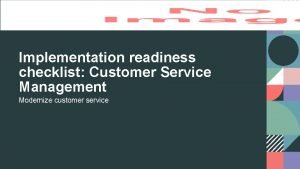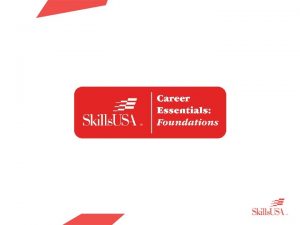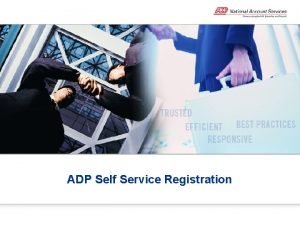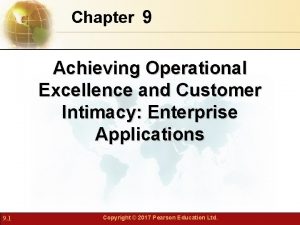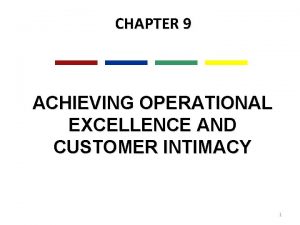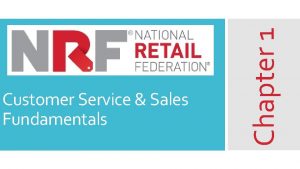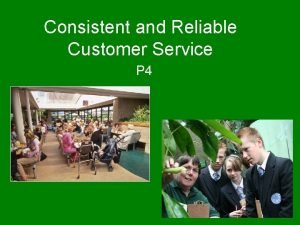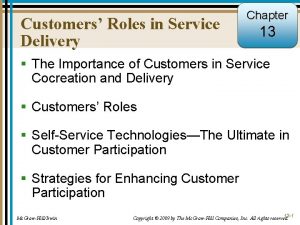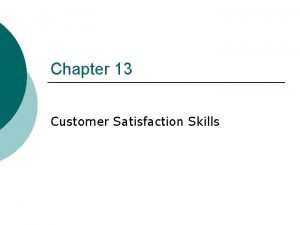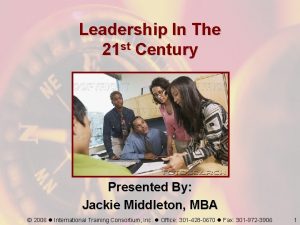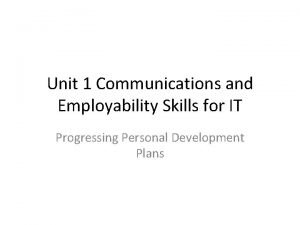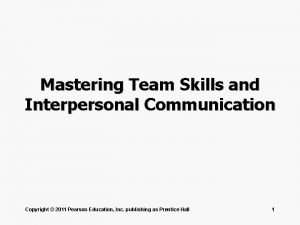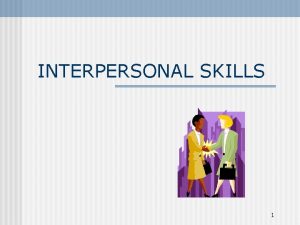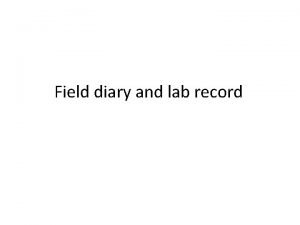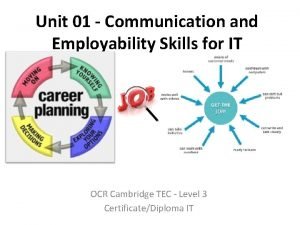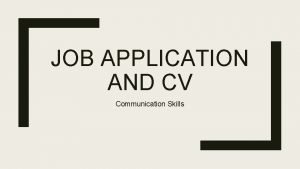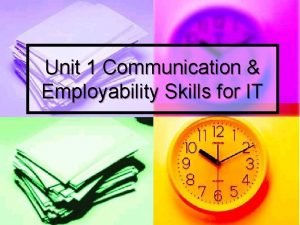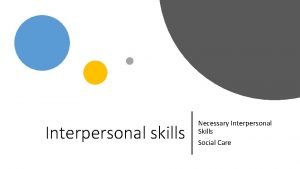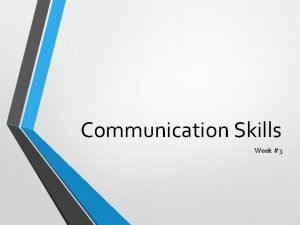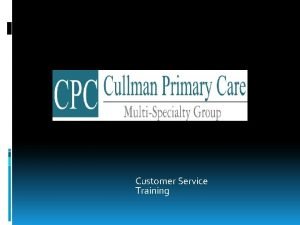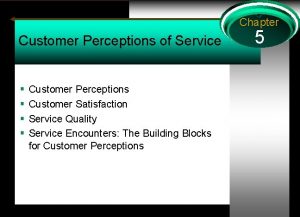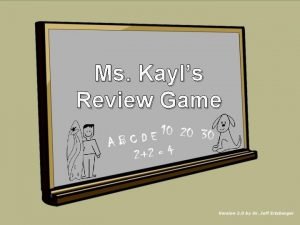Communication Skills and Customer Service 1 6 NEXT








































- Slides: 40

Communication Skills and Customer Service 1: 6 NEXT

Communication Security operatives regularly come into contact with members of the public during the course of their duties They also regularly interact with other members of staff and people from other organisations Effective communication is vital. People who are unable to communicate effectively may become frustrated. NEXT

How we communicate � � Communication is the sending and receiving of signals The ‘sender’ decides what thoughts they wish to pass on, ‘encodes’ those thoughts into the most effective form of communication, and then ‘sends’ those thoughts to the ‘receiver’ SENDER � The receiver takes in the message, understands it and replies if necessary. ENCODES THOUGHTS SENDER SENDS RECEIVER RECEIVES NEXT

Barriers to communication A barrier to communication is anything that can make effective communication difficult, or cause it to break down Common barriers include: ● ● ● ● Background noise Lighting Attitude Emotions Language difficulties Accents Jargon ● ● ● Learning difficulties Mental illness Physical limitations Drugs Alcohol Lack of understanding of the situation or role. NEXT

Types of communication Verbal communication is when we interact with another person using words and tone to convey our message The words we use are important obviously, but so is the tone in which we use those words. It’s not just what we say, but how we say it that counts. NEXT

Types of communication Non-verbal communication is everything else that we do when we communicate with another person on a face-to-face basis How we stand, what we are wearing, how close we are to the other person, facial expressions, eye contact, how we use our hands, other body gestures – these all help us to convey our message. NEXT

Types of communication Within the workplace we will also be conveying messages using written communication, in the form of reports, letters and e-mails. NEXT

Communicating in the workplace Communicating effectively in the workplace helps us to: � � � Get the job done Create a good impression of ourselves Reduce incidents of conflict, aggression and violence Security operatives need to come across as positive, assertive and professional at all times. People/ customers will not treat you with respect when the come into contact with. If you do not follow these golden rules. NEXT

Communicating in a team Effective communication in a team is essential Communication skills also play an important role in how we interact with our colleagues, supervisors and managers We should treat all members of staff with courtesy and respect, and we should expect to be treated in the same way. NEXT

Customers Internal customers � Internally, within our own company, our customers include our work colleagues, our supervisors, our managers and anyone working for any other company or organisation on the site External customers � Other customers we may come into contact with include visitors to the site, workmen, delivery drivers, the emergency services, neighbours and members of the public. NEXT

Diverse customer needs � � � All of our customers are: different people, with differing needs and expectations. They may come from different countries, they may be from different religions or may just be from a different age group. They may have different levels of physical or mental ability People form their own personal values as they grow up. Where they were born, where they live, how they were brought up, their friends and family, their jobs – all go towards forming a person’s values As security operatives, we need to take into account other people’s values, and try to choose the most appropriate and effective way of dealing with them. NEXT

Customer care One of our main roles as a security operative is looking after people How we treat people when we deal with them is very important Customer care is all about how we deliver our service and how we provide security to our customers on a day-to-day basis. NEXT

Good customer service Examples of how we can deliver good customer care include: � Being professional with every customer � � � � Being approachable Communicating with them effectively Acknowledging them Concerning yourself with the customer’s needs Building a rapport Treating customers as you would wish to be treated yourself Going out of your way to help customers Leaving customers pleased with how you have dealt with them. NEXT

Poor customer service Examples of poor customer care include: � Using poor communication skills � Showing a lack of commitment � Expressing a lack of concern � Not listening to the customer � Making jokes or being rude � Ignoring or failing to acknowledge the customer � Appearing bored or impatient � Failing to do what you have promised. NEXT

Communication in customer care Effective communications skills in delivering good customer care When we first deal with a customer we should: ● ● ● ● Make a good initial impression by acknowledging them Use their name if we know it Behave politely, positively and assertively Make appropriate eye contact Showing that we are willing to assist them Find out how we can help the customer Decide on the best course of action Leave the customer feeling that they have been dealt with professionally, correctly and pleasantly. NEXT

Telephone communications Using the telephone: � � � � � Be professional and polite at all times Use clear language Do not use unnecessary jargon Answer appropriately Follow with company guidelines Answer queries correctly Bear in mind confidentiality Important/urgent call must be recorded Pass all messages on promptly and accurately Do not promise things outside of your authority. NEXT

Radio communications Radios are important or even life-saving tools in a security operative’s armoury Care needs to be taken to ensure that radios are kept in good repair, that they are fully charged before a tour of duty, and that they are used correctly Effective radio communication between security teams and other people on site is essential, and helps to deal with incidents swiftly and efficiently. NEXT

Radio communications � Although radio procedures, call-signs and pro-words vary between different organisations, there a few basic guidelines that all security staff should follow. REMEMBER A ACCURATE B BRIEF C CLEAR All radio communication should be accurate, brief and clear NEXT

Using a radio When using the radio: � � � � Think about what you want to say Check that no-one else is already transmitting Press the transmission button but do not transmit immediately Position the microphone about 5 cm away from your mouth Speak clearly at normal speed and DO NOT SHOUT Use common procedure words (pro-words). Use an ear piece. You have to be aware of confidentiality and safety when transmitting a message. NEXT

Common pro-words include: HELLO – ‘I am calling’… NO PROBLEM, NO PROBLEM- Denotes you need to transmit a message but its no urgent. THIS IS – ‘My call-sign is’… OVER - ‘My transmission ends, please respond. ’ OUT – ‘End of transmission. ’ I SAY AGAIN – ‘I am repeating what I have just said…’ REPEAT – ‘Please repeat your transmission. ’ NEXT

Pro-words RECEIVED – ‘I have received and understood your message. ’ GO AHEAD – ‘Go ahead with your message to me. ’ STAND BY or WAIT – This usually means an important message is about to be transmitted so all airwaves need to be kept clear. ETA – ‘My estimated time of arrival is…’ ETD – ‘My estimated time of departure is…’ LEFT – RIGHT - (when giving directions). NEXT

Phonetic alphabet The NATO Phonetic Alphabet: � � Was developed in the 1950 s to be intelligible and pronounceable to all NATO allies in the heat of battle Is now widely used in business and telecommunications in Europe and the rest of the world Requires words to be spelled out by their letters during a conversation The normal alphabet cannot be used because some letters, for example P, B, C and D, sound similar and, over long distances, can be totally indistinguishable. NEXT

Phonetic alphabet LETTERS A Alpha H Hotel O Oscar V Victor B Bravo I India P W Whiskey C Charlie J Juliet Q Quebec X X-ray D Delta K Kilo R Romeo Y Yankee Lima S Sierra Z Zulu M Mike T Tango N November U Uniform E Echo F Foxtrot G Golf L Papa NEXT

Phonetic alphabet NUMBERS 0 Zero 5 Fife (five) 1 Wun 6 Six 2 Two 7 Seven 3 Tree (three) 8 Ait (eight) 4 Fower (four) 9 Niner (nine) NEXT

Q 1. Practice Phonetics. The letter A is: Apple Army Alpha

Wrong Answer

Correct Well done! NEXT

Practice Phonetics. The letter C is: Charlie Catch

Wrong Answer

Correct Well done! NEXT

Practice Phonetics. The letter H is: Hot Hand Hotel

Wrong Answer

Correct Well done!

Practice Phonetics. The letter Z is: Zebra Zulu Zap

Wrong Answer NEXT

Correct Well done! NEXT

Practice Phonetics. The letter S is: Sugar Sierra Solent

Wrong Answer NEXT

Correct Well done! NEXT

CONGRATULATIONS YOU CAN NOW GO ONTO THE TEST THAT COVERS ALL OF THE SECTIONS THAT YOU HAVE LEARNT SO FAR. Go to Test. You can refer back to this training at anytime for up to 90 days from registration after which your access will expire
 X.next = x.next.next
X.next = x.next.next Pengertian customer relationship
Pengertian customer relationship Customer service skills in hospitality
Customer service skills in hospitality Service readiness checklist
Service readiness checklist Technical skills for customer service
Technical skills for customer service Adp etime portal
Adp etime portal A customer is someone who
A customer is someone who Customer relationship management and customer intimacy
Customer relationship management and customer intimacy Customer relationship management and customer intimacy
Customer relationship management and customer intimacy Customer relationship management and customer intimacy
Customer relationship management and customer intimacy Managing marketing information to gain customer insights
Managing marketing information to gain customer insights Beyond customer satisfaction to customer loyalty
Beyond customer satisfaction to customer loyalty Intrapersonal personality
Intrapersonal personality Hard vs soft skills
Hard vs soft skills Bad customer service videos
Bad customer service videos Customer service and sales fundamentals
Customer service and sales fundamentals Service and follow up for customer retention
Service and follow up for customer retention Medical practice marketing and customer service
Medical practice marketing and customer service Consistent and reliable customer service
Consistent and reliable customer service Distribution customer service and logistics
Distribution customer service and logistics Distribution customer service and logistics
Distribution customer service and logistics Customer service in travel and tourism
Customer service in travel and tourism Service delivery roles
Service delivery roles Customer service features and benefits
Customer service features and benefits Customer service and cashier training courses
Customer service and cashier training courses What is next generation text service
What is next generation text service Network as a service for next generation internet
Network as a service for next generation internet Customer satisfaction skills
Customer satisfaction skills Need oriented selling
Need oriented selling Customer focused skills
Customer focused skills Next generation wireless communication market
Next generation wireless communication market Olass - offender learning and skills service
Olass - offender learning and skills service Essential skills ontario
Essential skills ontario Unit 1 communication and employability skills for it
Unit 1 communication and employability skills for it Mastering team skills and interpersonal communication
Mastering team skills and interpersonal communication Pengertian interpersonal skill
Pengertian interpersonal skill Field diary in communication
Field diary in communication Personal attributes valued by employers
Personal attributes valued by employers Communication skills cv
Communication skills cv Unit 1 employability skills
Unit 1 employability skills Interpersonal skills in social care
Interpersonal skills in social care



